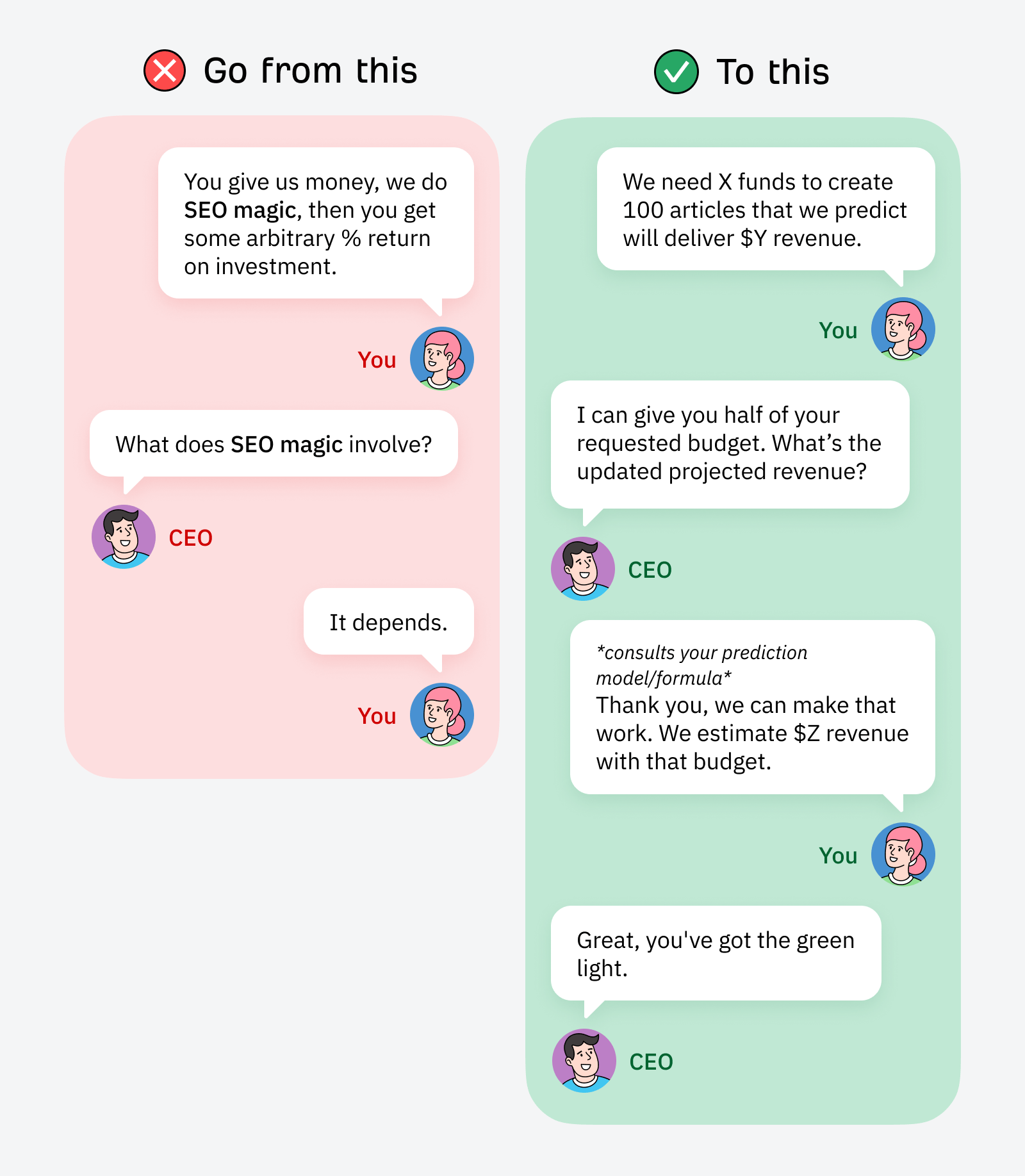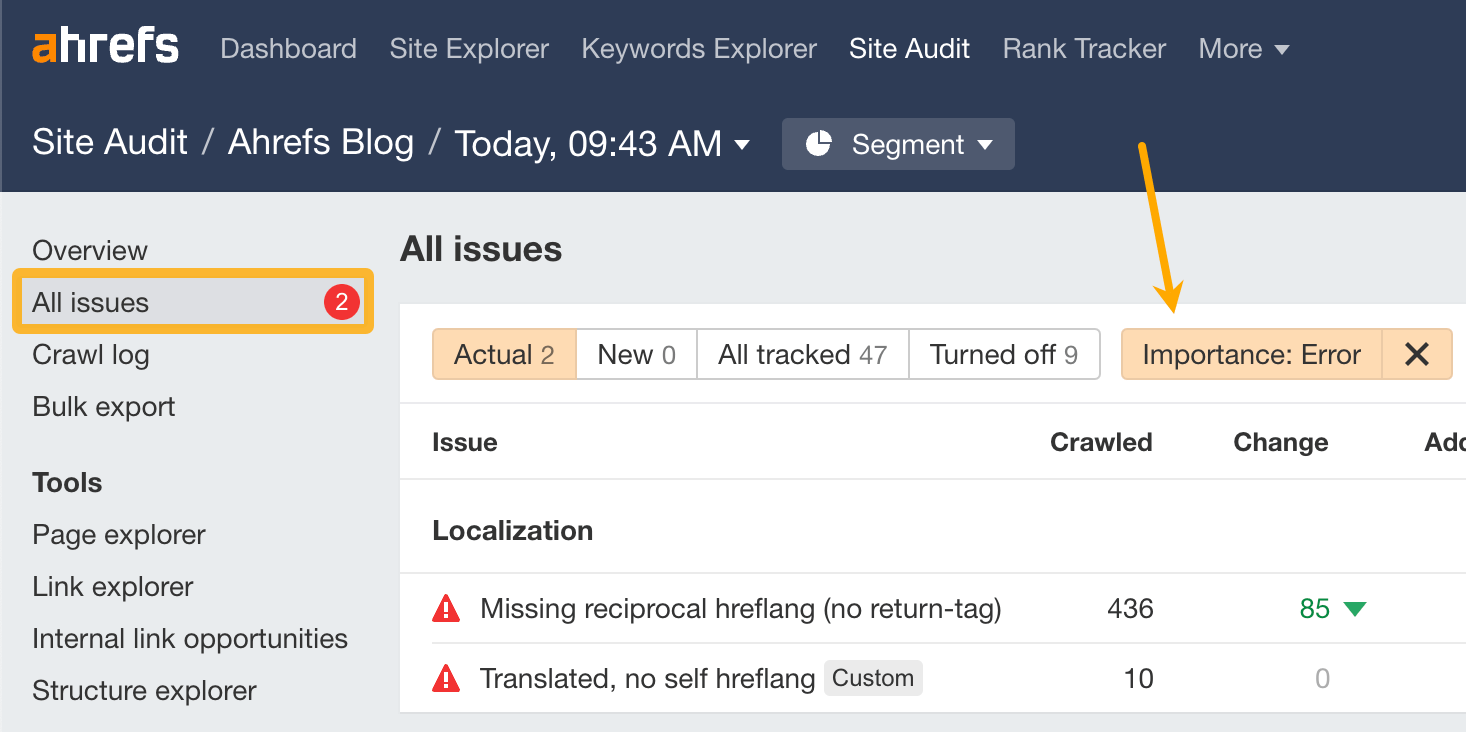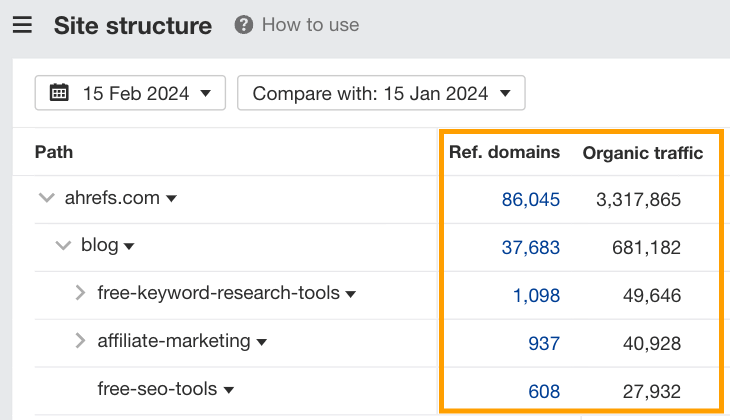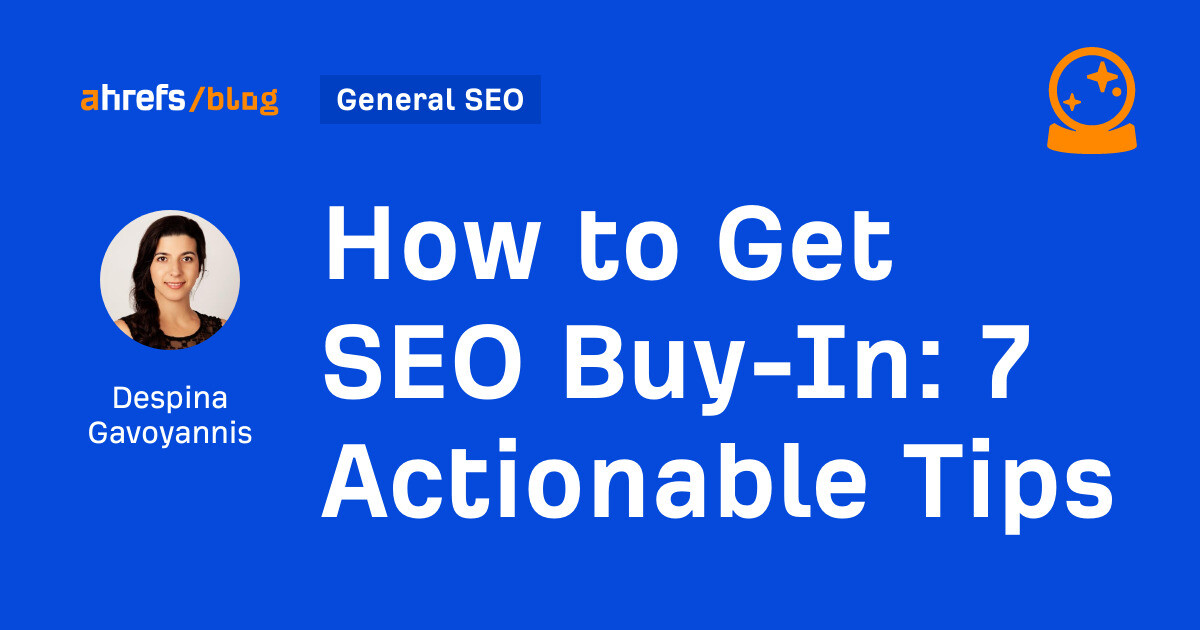For many SEOs in agency, in-house, or enterprise roles, 20% of their job is actually doing SEO, the other 80% is about soft skills like getting buy-in.
I always say that 20% of my job is actually doing the SEO, and 80% of communicating, getting buy-in, and moving the boulder so that [stakeholders] can succeed
At Ahrefs, multiple team members have worked in these roles, so we’ve compiled a list of our top tips to help you get more buy-in for SEO projects.
Start by identifying all the key influencers and decision-makers within the organization. You can check out the company’s org chart to figure out who’s who and who calls the shots on projects that impact SEO.
The executive team will likely be at the top of your list. But, we recommend working your way up to getting buy-in from executives by first working cross-functionally with decision-makers in engineering, product, editorial, marketing, or web accessibility teams.
They can each help you implement small parts of SEO that together can be a sizable contribution to the overall SEO strategy. They can also support your requests for funding or initiatives you pitch to executives later on.
To build relationships with decision-makers in these teams, consider the following:
- Who’s in charge of budgets and projects? ? Learn what they’re working on and how you can help each other with specific projects.
- What do they care about? ? This is the “what’s in it for me” factor. Align your SEO recommendations and requests to these things.
- How can they help implement your SEO recommendations? ? Identify the 20% of SEO they can easily help with using current resources.
Here’s an example of what that might look like:
| Who’s in charge? | What do they care about? | How can they help implement SEO? | |
|---|---|---|---|
| Engineering | Jane Doe, Head of Engineering | Jane cares most about rolling out new features on time and minimizing bugs. | Jane’s team can resolve many high-priority technical SEO errors if she sees them as bugs. |
| Editorial | Joe Blogs, Senior Editor | Joe cares most about publishing quality, brand-relevant content that leads to sales. | Joe’s team can create or optimize SEO content with buying intent to maximize traffic on commercial queries. |
Too often, SEOs lead with “I need X…” and end with “…for SEO”. Cue dramatic groans that echo company-wide.
Adapting your language and how you communicate is a minor action that can lead to big results in your mission to get buy-in for SEO. Communicating only what you need can often come across as an order and feels like extra work for someone else. Plus, it gives them no sense of why they should care or what’s in it for them.
Try this instead…
? Highlight opportunities: “There’s an opportunity to do X that helps with your goal of Y”
? Leverage FOMO: “If we don’t do X, you’ll miss out on Y”
? When speaking to executives: “I intend to achieve X by doing Y”
Sidenote.
“I intend” is one of my favorite takeaways from the book Turn the Ship Around. I highly recommend the read!
It also helps to give your project a fancy name. Every time you talk about the project, mention the name, repeat key facts, and highlight the most exciting opportunities the project opens up.
Repetition is gold as it helps non-technical stakeholders tie goals and results to an otherwise intangible initiative.
Most executives and department heads have no context for understanding SEO metrics like search volume, share of voice, or even organic traffic.
They don’t have an existing mental model to connect these numbers to. Therefore, when we start sharing SEO-specific numbers in meetings, many non-SEO stakeholders can’t easily approve specific actions or know how to make the right decisions—all because they can’t connect the numbers they’re already familiar with to the conversation about SEO.
Easy fix. Modify the metrics and actions you talk about to those that non-SEO stakeholders already understand.
For example, executives are likely churning over and obsessing about MBA-style metrics. CEOs think about things like revenue, market share, and profitability. Sales managers care about MQLs, SQLs, and so on.
Here are some examples of how to translate SEO lingo for non-SEO stakeholders. These are inspired by Tom Critchlow’s interview on Voices of Search.
Monthly traffic ? Lifetime traffic value e.g., “By creating X content, we can get Y monthly traffic predict Y lifetime traffic value.” HINT: Multiply Ahrefs’ Traffic Value metric by 60 to get a 5-year estimate, a common timeframe for calculating lifetime metrics.

Share of voice ? market share e.g., “By doing X, our share of voice SEO market share has grown Y%. We’d like funds to do more of X.”
Traffic growth ? revenue growth e.g., “We can grow organic traffic predict Y% revenue growth from SEO if we hit X traffic targets. These are the project milestones that will get us there…”
It depends ? forecasts e.g., CEO asks “What’s it going to get us?”… “It depends. I made a model that forecasts approximately X% growth in Y months.”
It doesn’t matter what specific metrics are used in your organization. You can adapt SEO metrics to the ones everyone in the company is already thinking about. The main goal of doing this is to take SEO from being a mysterious “black box” activity to something measurable and relatable to non-SEO stakeholders.

Devs and engineers are essential SEO allies within any organization. And while you can often skip the lengthy relationship-building phase and jump straight into tech fixes, how you frame your requests still matters.
Don’t be the kind of SEO that constantly gives them extra work “because it’s good for SEO.”
Instead, tie in your requests to what they care about. Fixing bugs is an easy approach to take here because devs already understand and care about these things for reasons unrelated to SEO.
Jackie Chu’s 2023 MozCon presentation outlined this brilliantly. A bug typically:
- Delivers a confusing brand experience
- Impacts customers (humans and bots)
- Impacts other channels, like SEM
If pages can’t render, that’s a bug. If there are content differences between mobile and desktop, that’s a bug. Anything that needs improvement in Ahrefs’ Site Audit is, you guessed it, a bug.
That said, not all bugs are created equal. If you bother devs with a load of super minor or unimportant issues 24/7, they’ll learn to ignore you. So, make sure to prioritize and only ask for bug fixes that matter.
You can easily do this by filtering your Site Audit results by importance:

Submit:
- Errors as high-priority
- Warnings as medium-priority
- Notices as low-priority
You can also show your dev team how to interpret each issue listed and find the steps they can take to fix them by clicking on the “?” next to specific issues.

Too many SEOs pitch projects without considering everything that’s needed to make them happen. You’re more likely to get buy-in if your pitch is specific and shows decision-makers the exact details around things like the project’s cost, resources required, and expected timelines.
For example, say you need 100 articles published within three months. Make sure you chat with your editorial and development teams first. See if they can fit this project in and what resources they need to make it happen.
Then, build those resources into your pitch:
? Instead of: “I’d like to publish 100 articles on the blog within three months and estimate I’ll need $X per article”.
? Try this: “To get 100 articles on the blog, which we estimate will contribute to $X in lifetime traffic value, we’ll need to hire a freelance writer and dedicate two development sprints to the project within the next three months. Jane from engineering and Joe from editorial are collaborating on this with me, and we estimate a cost of $Y.”
Need to convince the Jane’s and Joe’s in your organization to partner with you? No worries. Check out the next point.
SEO is chronically underfunded and underresourced… but so are most other teams. You can become an ally and help other teams get more resources because they’re helping implement your SEO strategy.
They get more of whatever they need (people, money, resources). You get their help with SEO tasks, and they get prioritized. Win-win for you and your new BFF.
You can get the ball rolling by pitching a small test or project that is easy for the other team to get on board with.
Avoid this ? “I need 10 of the articles you’re working on each month to do X for SEO”.
Try this instead ? “There’s an opportunity for us to do X, and it will allow you to meet Y KPIs. Can we run a small test (and build a case for the execs) so you can hire another writer to work on this project?”
Small tests are a great way to warm up a new contact within your organization, especially if there’s a clear benefit they’ll receive if the test works.
Test results are also very helpful when pitching to executives down the track. If you can demonstrate small-scale success in one area, it’s much easier to get funding for bigger projects that can piggyback on those early wins.
Even if the initial pitch is for another team to get funding, you’re getting your foot in the door for bigger projects. Plus, you’re essentially getting free SEO if you can leverage the other team’s resources for your benefit.
A good habit for every SEO to develop is to link everything to strategic objectives. We need to get better at pitching the strategic value that our projects deliver instead of the actual work we need to do.
No one cares about the hundreds of technical fixes we need to work on. But everyone cares about revenues dropping if we don’t get support for technical fixes that affect conversions (and SEO, of course, but they don’t need to know that).
Key note here: strategic objectives go beyond metrics. They include things like:
- Entering international markets
- Becoming the market leader
- Expanding X division
You get the idea.
Here are the tactics we’ve found that help position SEO as strategically valuable.
Compare against competitors
This tactic has a very high success rate in our team’s experience. When ideating this blog post, Tim, Patrick, Chris, and Mateusz all cited great success with this approach, and my own experiences echo this.
It works for literally any SEO activity you’re pitching, especially if you’re in a fierce market with SEO-savvy competitors who are already doing the thing you’re recommending.
For example, you could try the following different pitch angles:
? Closing the gap: “If we did X, we’d be able to close these gaps with our biggest competitor in Y months…”
? Reverse engineering: “Our biggest competitor did X. If we dedicated Y resources, we could close the gap and outpace them within Z months.”
? Becoming a pacesetter: “There’s a gap in the market and none of our competitors are leveraging it. X resources would allow us to take Y actions that give us a competitive edge and make it difficult for competitors to catch up.”
No matter your angle, an easy place to start is in Ahrefs’ Site Structure report. Here, you can see what strategies your competitors are using along with high-level performance metrics, like organic traffic and the number of referring domains that different website segments get.

Compare against internal departments
Another great approach is to bring your pitch back to what’s going on in other areas of the organization.
This is a great tactic to benchmark the value of SEO in a way that is immediately apparent. It’s also a great way to get easy buy-in if your company’s strategic objectives focus on specific divisions or products.
Here are some pitching angles you can try:
? Expanding a division: “We need X resources to help division A expand to the level of division B.”
? Improving KPIs: “Product A has a high cost per acquisition. We were able to lower CPA by X% for product B using SEO. If we had access to Y resources, we could repeat these actions for product A.”
? Learning from mistakes: “We learned lessons A, B, and C from a past product launch. If we had X resources, we could help launch the new product for division A without repeating past mistakes.”
Forecast opportunity costs
Opportunity costs are the lost benefits you experience when choosing an alternative option. When it comes to getting buy-in for SEO, it can help to show what the opportunity cost would be if decision-makers chose not to invest in SEO.
It’s super easy to do this using Ahrefs’ traffic value metric.

This metric shows you how much you’d be spending on paid ads to get the same traffic you do through SEO. It has opportunity cost baked right into it!
You can use it in a few different ways. My favorite method is to look at a successful segment of the website and use its metrics to forecast potential success for a new segment you want to optimize or build-out.
For example, here you can see how the French segment of our site compares with the Spanish segment.

Want to launch into a new international market? Use these metrics to build a case of what you’d be missing out on by not expanding.
Want to improve an underperforming segment of your site? Show that segment vs a segment that’s skyrocketing to your executive team.
My second favorite method is to use the Traffic Value metric to pit SEO against Google Ads or other marketing channels and showcase how SEO compounds over time and costs less in the long run.
Realistically, if there’s a marketing budget to be had, and it doesn’t go to SEO, these are the alternative channels it will likely go to. So, positioning SEO as a worthwhile channel to invest in can get you a bigger slice of the budget.
For instance, you could pitch something like, “Our forecasts show that we could reduce our cost per click to $X (traffic value / traffic) by investing Y resources into SEO instead of [another channel].”
If your website is fairly new or you don’t have existing successes to leverage, you can do both of the above by using a competitor’s website as a proxy until you start getting some results that you can use in future forecasts.
So, your pitch would be more like: “X competitor is saving up to $Y (traffic value) in Google ads costs by using SEO. We’re leaving money on the table by not investing in SEO.”
Key Takeaways
Good SEO is about giving people what they want. Getting buy-in is the same, just for a different audience.
The more you help others in your organization get what they want, you’ll also get what you want.
When it comes to collaborating with other departments, it comes down to helping them meet their KPIs because they’re working with you. It builds a positive relationship where they feel happy to help you out in the future and are more likely to prioritize SEO projects.
As for getting buy-in from executives, understanding where they spend most of their mental energy and aligning your projects to those things can go a long way.
If you’ve got any questions or cool tactics to share, reach out on X or LinkedIn any time!




